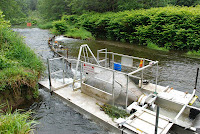We began our section on marine community ecology this week with Bruce Menge. We have spent the last few weeks learning about the organisms in Oregon’s intertidal zone, and this week we got to learn about the bigger picture and how the organisms interact together and make up a community. Our field trips were very different this week compared to past field trips, even though we still visited Strawberry Hill and Boiler Bay. We had to get up before sunrise to catch the low tides along with spending several hours working in the field. This week, instead of searching for certain taxa, we have been learning several different community surveying techniques. Techniques such as conducting biodiversity counts, observing welk and seastar diets, determining tidepool biodiversity, and using transects and quadrats to determine biodiversity.
 |
Hard at work using transects and quadrats to determine biodiversity
|
 |
We completed 120 of these quadrat surveys as a class
over the course of the week |
Learning about the community structure in the rocky intertidal is important because it is a model ecosystem that could aid in answering some broader ecological questions and can be used as a baseline for other ecosystems and can shed light on better resource management.
Each day after the field, we got together in groups and organized and analyzed our data, so that we can write reports on our findings next week.
We had four guest lecturers this week (Sarah Close, Liz Cerny‐Chipman, Chenchen Shen, and Jeremy Rose) all PhD candidates presenting their research. It was exciting to see real world applications of what we were learning in class.
 |
| Pachygrapsus crassipes |
While we were in the field, we got to see some really interesting species that we haven’t come across in previous weeks. In Manipulation Bay (below the main parking lot of Boiler Bay), Aubree found a dead Longnose Skate, Raja rhina, washed up in the low intertidal zone, we found a Striped Shore Crab, Pachygrapsus crassipes, a spawning Pisaster ochraceous at Strawberry Hill, and a polychete in Yaquina Bay during survey practice.
 |
| Raja rhina |













